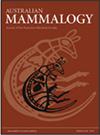与聚光灯相比,热像仪在不同环境温度下对干旱区哺乳动物计数的有效性
IF 1.2
4区 生物学
Q3 ZOOLOGY
引用次数: 3
摘要
有效监测哺乳动物物种对其管理至关重要。与借助聚光灯的目视观察相比,热像仪可以更准确地探测夜行哺乳动物。我们的目标是测量热像仪在检测方面的改进,并确定这些改进是如何依赖于环境温度和哺乳动物物种的。我们监测了澳大利亚中部的中小型哺乳动物,包括小型啮齿动物、兔狸、兔耳袋狸、欧洲兔和野猫。我们在环境温度从10°C到35°C的范围内,使用聚光灯和热像仪进行了20个车载相机样带。热像仪检测到的小型啮齿动物和中型哺乳动物更多。野猫没有增加的好处,可能是因为它们的眼睛很亮。我们发现使用热像仪增加的检测与环境温度之间存在很强的关系:在大约15°C时,热像仪比传统聚光灯检测到的动物多30%,但在30°C以上很少产生额外的检测。聚光可能更通用,因为它可以在更大范围的环境温度下使用,但热像仪在低温下比视觉测量更准确,并且可以用于基准聚光测量。本文章由计算机程序翻译,如有差异,请以英文原文为准。
Effectiveness of thermal cameras compared to spotlights for counts of arid zone mammals across a range of ambient temperatures
Effective monitoring of mammal species is critical to their management. Thermal cameras may enable more accurate detection of nocturnal mammals than visual observation with the aid of spotlights. We aimed to measure improvements in detection provided by thermal cameras, and to determine how these improvements depended on ambient temperatures and mammal species. We monitored small to medium sized mammals in central Australia, including small rodents, bettongs, bilbies, European rabbits, and feral cats. We conducted 20 vehicle-based camera transects using both a spotlight and thermal camera under ambient temperatures ranging from 10°C to 35°C. Thermal cameras resulted in more detections of small rodents and medium sized mammals. There was no increased benefit for feral cats, likely due to their prominent eyeshine. We found a strong relationship between increased detections using thermal cameras and environmental temperature: thermal cameras detected 30% more animals than conventional spotlighting at approximately 15°C, but produced few additional detections above 30°C. Spotlighting may be more versatile as it can be used in a greater range of ambient temperatures, but thermal cameras are more accurate than visual surveys at low temperatures, and can be used to benchmark spotlight surveys.
求助全文
通过发布文献求助,成功后即可免费获取论文全文。
去求助
来源期刊

Australian Mammalogy
ZOOLOGY-
CiteScore
2.50
自引率
8.30%
发文量
26
期刊介绍:
Australian Mammalogy is a major journal for the publication of research in all branches of mammalogy. The journal’s emphasis is on studies relating to Australasian mammals, both native and introduced, and includes marine mammals in the Antarctic region. Subject areas include, but are not limited to: anatomy, behaviour, developmental biology, ecology, evolution, genetics, molecular biology, parasites and diseases of mammals, physiology, reproductive biology, systematics and taxonomy.
Australian Mammalogy is for professional mammalogists, research scientists, resource managers, consulting ecologists, students and amateurs interested in any aspects of the biology and management of mammals.
Australian Mammalogy began publication in 1972 and is published on behalf of the Australian Mammal Society.
 求助内容:
求助内容: 应助结果提醒方式:
应助结果提醒方式:


